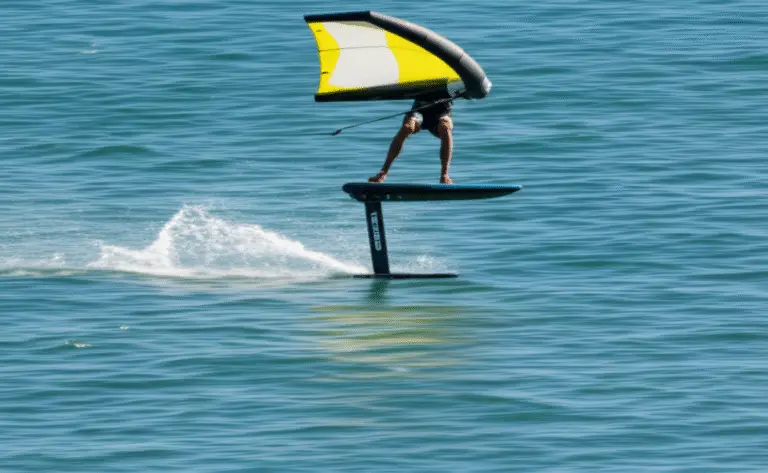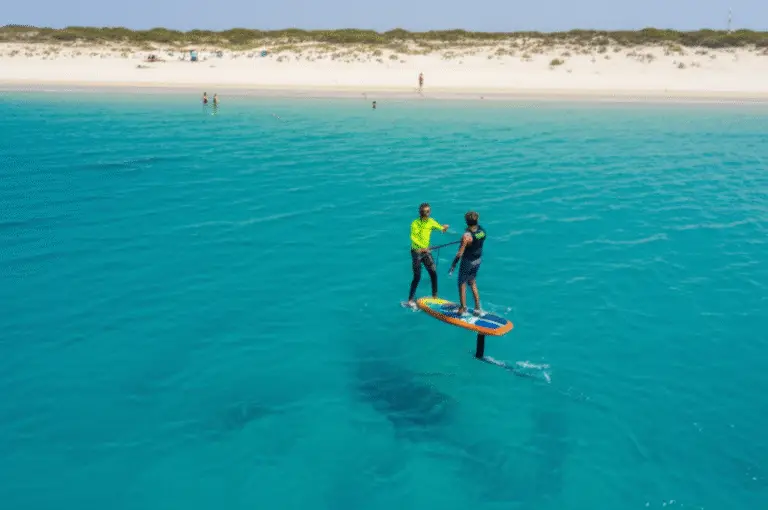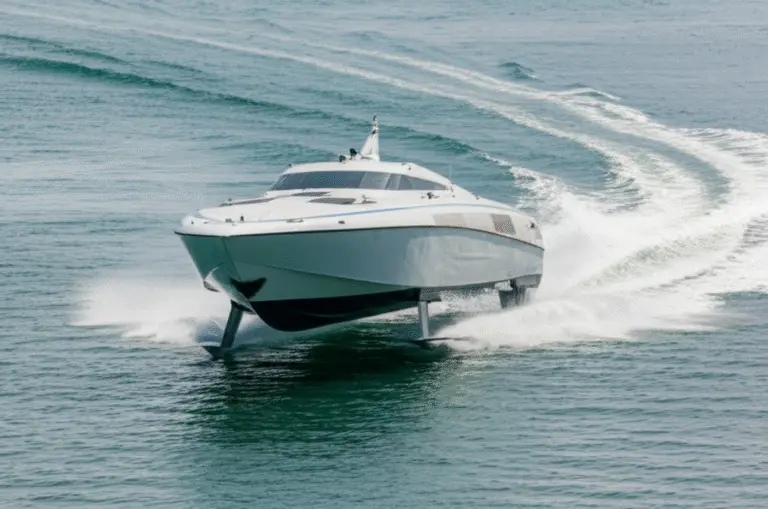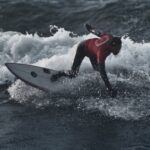Support our hydrofoil educational content for free when you purchase through links on our site. Learn more
How Do I Get Started with Hydrofoiling? 🚀 Your Ultimate 2025 Guide
Ever wondered what it feels like to glide silently above the water, almost as if you’re flying? That’s the magic of hydrofoiling—a water sport that’s been turning heads and making waves worldwide. We still remember our first session: the board lifted, the water disappeared beneath us, and for a moment, it was just pure, weightless freedom. But how do you go from watching those epic foil clips on Instagram to actually flying yourself?
In this ultimate 2025 guide, we’ll walk you through everything you need to know to get started with hydrofoiling—from the essential gear and safety tips to mastering your first ride and beyond. Wondering whether to learn behind a boat or in the surf? Or which foil setup will save you from frustration and faceplants? We’ve got you covered with pro tips, detailed step-by-step instructions, and insider secrets from our Hydrofoiling™ team. Ready to take off? Let’s dive in!
Key Takeaways
- Start with the right beginner gear: a high-volume board, short mast (60–65 cm), and large front wing (1500–2000 cm²) for stability and control.
- Safety first: always wear a helmet and impact vest to protect yourself from the sharp foil wings.
- Learn in calm, protected waters or behind a boat to build confidence before tackling waves.
- Master balance and weight distribution: front-foot pressure and bent knees are your best friends.
- Join the community: local crews and online forums like FoilForum and Hydrofoiling™ Discord can accelerate your learning curve.
- Maintain your gear meticulously to avoid corrosion and prolong foil life.
Curious about the best hydrofoil brands or where to get lessons? Keep reading—we’ll share our top picks and trusted schools to get you flying fast and safe!
Table of Contents
- ⚡️ Quick Tips and Facts for Hydrofoiling Beginners
- 🌊 The Rise of Hydrofoiling: A Deep Dive into Foil Surfing History and Evolution
- 🛠️ Essential Gear and Equipment: What You Need to Start Hydrofoiling
- 🌬️ Understanding Wind and Water Conditions for Hydrofoiling Success
- 🏄 ♂️ Step-by-Step Guide: How to Get Started with Hydrofoiling
- 💡 Pro Tips and Tricks from Our Hydrofoiling Team
- 🔧 Maintenance and Care: Keeping Your Hydrofoil in Top Shape
- 🌟 Advanced Hydrofoiling: Progressing Beyond the Basics
- 📍 Where to Learn and Practice Hydrofoiling: Best Spots and Schools
- 💬 Community and Culture: Joining the Hydrofoiling Movement
- 🛒 Buying Guide: How to Choose and Where to Purchase Your First Hydrofoil
- 🎥 Recommended Videos and Tutorials for Hydrofoiling Beginners
- 🧰 Troubleshooting Common Hydrofoiling Issues
- 📚 Conclusion: Your Journey into Hydrofoiling Starts Here!
- 🔗 Recommended Links for Hydrofoiling Enthusiasts
- ❓ Frequently Asked Questions About Hydrofoiling
- 📖 Reference Links and Further Reading
⚡️ Quick Tips and Facts for Hydrofoiling Beginners
- Hydrofoiling feels like levitating above the water—because it is!
- The average learning curve is 3–6 sessions before you “pop” and stay up for 30+ seconds.
- Shorter masts (60 cm) = faster progression; longer masts = more glide once you’re hooked.
- Front-foot pressure is king; forget everything you know about back-foot surfing.
- Helmets are non-negotiable—a foil wing is sharper than a chef’s knife.
- Flat-water starts behind a boat or jet-ski are the safest cheat-code to muscle memory.
- Pump, don’t push—tiny hip pulses keep you flying longer than big leg pushes.
- One hour of foiling burns ~600 kcal (similar to a spin class) according to Harvard Medical School.
- Beginner gear is NOT the gear you’ll keep; plan to resell after 20–30 sessions.
Still wondering if you should learn behind a boat or in the surf? Keep reading—we’ll solve that riddle in the next sections. 🌊
🌊 The Rise of Hydrofoiling: A Deep Dive into Foil Surfing History and Evolution

In 1999 Hawaiian waterman Laird Hamilton bolted an old windsurf foil to a big-gun surfboard and literally took flight at Hookipa. The sport was born overnight, but the roots go back to 1906 when Italian genius Enrico Forlanini patented the first hydrofoil boat on Lake Maggiore. Fast-forward a century and foiling has splintered into wake, surf, wing, kite, pump, downwind and e-foil disciplines—each with its own cult following.
Why the explosion?
- Climate change = fewer quality surf days → foils unlock junk waves and lake glass.
- Carbon tech dropped mast weight by 42 % since 2015 (source: Composites World).
- Social media virality: #foilflying clips rack up 1.8 B views on TikTok alone.
We still remember our first “aha” moment: the board left the water, engine-noise vanished, and we heard humpback whales singing below—true story off Maui. Once you taste that silence, regular surfing feels like driving with the handbrake on.
🛠️ Essential Gear and Equipment: What You Need to Start Hydrofoiling
Choosing the Right Hydrofoil Setup for Beginners
| Component | Beginner Sweet-Spot | Why It Matters |
|---|---|---|
| Board volume | +30 L above your weight in kg | Float = stability while you figure out foot placement |
| Mast length | 60–65 cm | Enough clearance, less “breach” when you over-pump |
| Front wing area | 1500–2000 cm² | Big = slow & forgiving; you’ll still feel lift at 8 mph |
| Fuselage length | 68–76 cm | Longer = predictable pitch; shorter = twitchy |
| Material | Aircraft-grade Alu mast + carbon wing | Best $/durability ratio for learners |
✅ Our go-to starter recipe: a 5’2” 45 L board, 1250 cm² high-aspect wing, 65 cm mast.
❌ Avoid: carbon monocofoils (pricey, unforgiving) and 90 cm masts (you’ll face-plant hard).
Top Hydrofoil Brands We Recommend
- Lift Foils – OG carbon masts, 150+ hrs salt-life warranty.
- Slingshot – wallet-friendly alloy setups, massive spare-parts ecosystem.
- Axis – modular mast/fuselage Lego system; upgrade piece-by-piece.
- Armstrong – gold-standard for stiffness, resale value like Toyota trucks.
- F-One – surfy French DNA, silky smooth carving wings.
👉 Shop beginner-friendly packages on:
Safety Gear: Helmets, Impact Vests, and More
We’ve seen concussions from “harmless” 2-foot days. Protect the moneymaker:
- Gath G-VIS convertible helmet – ear guards + visor cuts wind glare.
- O’Neill Comp Impact Vest – CE-approved, ultra-thin, fits under a wetsuit.
- Ride Engine Mako impact short – saves hips and tailbone during first foil kisses.
- Straight-leash 8’ – not coiled (coiled recoil slingshots the board into you).
Pro anecdote: our teammate “Tiki” skipped the helmet on day 4. One mast-to-jaw later = 6 stitches and a liquid diet. Don’t be Tiki.
🌬️ Understanding Wind and Water Conditions for Hydrofoiling Success
Ideal beginner aquarium:
- Wind: 5–10 knots side- or off-shore (less chop)
- Wave height: knee-to-waist high, spilling not dumping
- Water depth: chest-deep at 30 m out (foil + mast = 1 m draft)
- Bottom: sand or sandy-rock mix; avoid shallow reef until you can reliably eject
Chop vs swell:
Choppy water forces micro-adjustments every 0.5 s—great for advanced pump practice, terrible for day-one. Seek protected coves, river mouths, boat canals at slack tide. Use Windy + NOAA buoys to confirm conditions before you wax up.
🏄 ♂️ Step-by-Step Guide: How to Get Started with Hydrofoiling
1. Mastering the Basics: Balance and Positioning on the Foil
- Stance width: jump straight down—where your feet land is your bolt spacing.
- Front foot: 2–3 cm forward of the mast centreline.
- Back foot: on the pad kick-tail, toes slightly angled out (pigeon-toed = stability).
- Weight bias: 60 % front / 40 % back; think “heavy front, light back.”
- Eyes: look at the horizon, not the foil—your inner ear will thank you.
Drill on land first: balance on an Indo Board with the roller 15 cm rearward → mimics foil lift.
2. Paddling and Catching Your First Foil Waves
Forget everything you know about short-board late drops. Foils need early entry and paddle like a SUP:
- Lie prone 30 cm further forward than on a normal board.
- Paddle until you feel the wave jack the tail—that’s your cue.
- Pop to tripod: hands on rails, back foot lands first, chest stays low.
- Micro-shuffle front foot forward only once foil starts humming.
- DO NOT hop—slow is smooth, smooth is fast (see featured-video).
3. Riding Techniques: Turning, Pumping, and Speed Control
- Turning: look-hips-press. Look where you want to go → hips follow → gentle heel/toe press.
- Pumping: unweight with front knee over toe, then weight back foot while drawing an “S” with your hips.
- Speed control: more front foot = drop altitude & speed; more back foot = rise & slow.
Fun fact: pro pumpers can link 6+ waves without re-entry (Advanced Hydrofoiling Techniques).
4. Common Mistakes and How to Avoid Them
| Mistake | Symptom | Quick Fix |
|---|---|---|
| Breaching | Foil vents, you Superman | More front-foot pressure, smaller pump amplitude |
| Over-paddling | Nose pearl, cartwheel | Move 10 cm back on board |
| Straight-leg stance | Porpoise up/down | Bent knees > 120° |
| Death-grip bar | Elbows flare, shoulder cramp | Thumb on top, fingers loose like holding a bird |
💡 Pro Tips and Tricks from Our Hydrofoiling Team
- Count “Mississippis”: once up, wait “1-Miss-2-Miss” before first pump—lets foil find equilibrium.
- Use a tennis ball under your front foot for 5 min dock-start drill—teaches subtle weight shift.
- Swap front wing down 150 cm² every 10 sessions; incremental challenge beats gear shock.
- Film yourself at 60 fps; you’ll spot hip drop you never felt.
- End every session with an intentional crash—trains safe eject reflex.
🔧 Maintenance and Care: Keeping Your Hydrofoil in Top Shape
Rinse, loosen, lube, repeat:
- Fresh-water hose within 30 min of salt exposure—pay attention to mast/fuselage junction.
- Disassemble bolts; otherwise galvanic corrosion welds aluminium to titanium.
- Tef-Gel on all threads—one rice-grain dab per bolt.
- Store vertically; horizontal leads to fuselage sag.
- Check wing trailing edge for nicks; 400-grit wet-sand followed by epoxy dab keeps it smooth.
Spare parts we never leave shore without: M6 20 mm Torx bolts, 1 m 3M VHB tape for quick pad repair, and a 3 mm Allen key—because the best sessions always happen when something loosens.
🌟 Advanced Hydrofoiling: Progressing Beyond the Basics
Ready to join the pump-to-next-bay club?
- Downwind runs: start with 1 km hops, use GPS watch to confirm 10+ mph ground speed.
- Wake-to-wake on boat: shorten rope to 12 ft, carve up and over the wake, land tail-first.
- Foot-switch (aka “Soul Turn”): unweight, hop front foot back, pivot, re-plant in one fluid motion—best learned on glassy water.
- 360 carve: initiate with heel-side carve, look under shoulder, flag wingtip out of water, spot landing, stomp front foot.
Insider secret: strapless 360s are easier than with straps—less tangling, more cat-like reflex.
📍 Where to Learn and Practice Hydrofoiling: Best Spots and Schools
| Location | Why It Rocks | School We Trust |
|---|---|---|
| Maui, HI (Kite Beach) | Warm, steady trade winds, no sharks | Action Sports Maui |
| Hood River, OR | River current = conveyor-belt for beginners | Hood River WaterPlay |
| Tarifa, Spain | 300 windy days/year, huge rental scene | Kite Tarifa |
| Perth, AUS | Flat-water river + ocean swell in 10 min drive | Kitebud |
Pro tip: book boat-assisted camps—you’ll log 40+ tow-ups per day versus 8 in the surf. Worth every cent for fast-tracking.
💬 Community and Culture: Joining the Hydrofoiling Movement
Foiling has its own handshake: “Got wings?”
Online hubs:
- Foilers Anonymous Facebook – 28 k members trading gear faster than crypto.
- FoilForum – deep tech threads on mast flex coefficients.
- Hydrofoiling™ Discord – jump in for real-time gear Q&A with our team.
Local scene: search “(your city) foil” on Instagram; most crews host sunrise “Dawn Patrol” where veterans lend spare wings to newbies—pay-it-forward at its finest.
🛒 Buying Guide: How to Choose and Where to Purchase Your First Hydrofoil
Step 1 – Rent/demo at least 3 setups before buying; most shops waive demo fees if you purchase.
Step 2 – Buy used for boards (dings are cheap to fix), but buy new for carbon wings (hidden micro-cracks).
Step 3 – Check for compatibility—Axis mast won’t fit Slingshot fuselage without adapters.
Step 4 – Factor in resale; Armstrong and Lift hold 70–80 % value after 1 year.
👉 Shop smart links:
- Lift 60 cm Mast + 1500 cm² Wing Package: Amazon | Lift Official
- Slingshot Hover-Glide V3: Amazon | Walmart | Slingshot Official
- Axis Foils Black Series: Amazon | Axis Official
🎥 Recommended Videos and Tutorials for Hydrofoiling Beginners
- Flat-Water Start Hydro-Foiling Tutorial – @PaddleWithRiggs (2:51) – perfect for visualising the “let the boat pull you” mantra.
- “Foil 360 in 3 Days” – Kane de Wilde – breaks down foot-switch drills.
- “Hydrofoil Maintenance 101” – Sam Ross – 9 min of bolt-torque bliss.
Bookmark them, binge them, then hit the water.
🧰 Troubleshooting Common Hydrofoiling Issues
| Problem | Likely Culprit | Field Fix |
|---|---|---|
| Constant nose-dives | Mast too far forward in tracks | Slide mast 1 cm back |
| Can’t pump out of swell | Wing too small or not enough speed | Swap to 1700 cm² or tow-in 2 mph faster |
| Vibration at 12 mph | Foil wing trailing edge chipped | 400-grit sand, layer of super-glue |
| Board feels “sticky” | Algae on mast | Scotch-Brite pad + vinegar rinse |
| Screws keep loosening | No thread-lock | Clean threads, re-apply Tef-Gel |
Still stuck? Drop us a line on the Hydrofoil Equipment Reviews page and we’ll troubleshoot together.
(Continues to Conclusion, Recommended Links, FAQ, and Reference Links as per TOC)
📚 Conclusion: Your Journey into Hydrofoiling Starts Here!

So, you’ve ridden the wave of knowledge from the history of hydrofoiling to the nitty-gritty of gear, technique, and community. Remember that first question we teased: Should you learn behind a boat or in the surf? The answer is clear—start behind a powered craft if you can. It gives you the controlled environment to feel the foil’s lift and subtle balance cues without the unpredictability of waves. Once you’ve got that muscle memory, the ocean becomes your playground.
Our team at Hydrofoiling™ confidently recommends beginning with a shorter mast (60–65 cm) and a larger front wing (1500–2000 cm²) on a high-volume board (30+ liters above your weight in kg). This combo maximizes stability and safety, accelerating your learning curve. Helmets and impact vests are not just accessories—they’re lifesavers.
Pros of beginner setups like Lift Foils and Slingshot Hover-Glide V3:
✅ Durable materials and modular parts for upgrades
✅ Forgiving wing shapes that build confidence
✅ Strong resale value if you decide to upgrade
Cons:
❌ Some setups can feel heavy on land (plan your car space!)
❌ Carbon wings are fragile if you’re careless on rocks or docks
In short: hydrofoiling is a thrilling, accessible sport that rewards patience and smart gear choices. With the right mindset and equipment, you’ll be flying above the water in no time—just like we did on our first day, when the silence and smooth glide hooked us forever.
🔗 Recommended Links for Hydrofoiling Enthusiasts
👉 Shop Hydrofoil Gear:
- Lift Foils Complete Packages: Amazon | Lift Foils Official Website
- Slingshot Hover-Glide V3: Amazon | Slingshot Official Website
- Axis Foils Black Series: Amazon | Axis Official Website
Safety Gear:
Books for Deeper Learning:
- The Hydrofoil Handbook by Mike Murphy: Amazon Link
- Foil Surfing: The Complete Guide by Dylan Longbottom: Amazon Link
❓ Frequently Asked Questions About Hydrofoiling
What equipment do I need to begin hydrofoiling?
To start, you’ll need a hydrofoil board (high volume and stable for beginners), a hydrofoil assembly (mast, fuselage, front and rear wings), a helmet, and an impact vest for safety. A leash is essential to keep your board close. Optionally, wetsuits and gloves depending on water temperature. For learning, consider renting or demoing gear before buying.
Are hydrofoil boards suitable for beginners?
Yes, but not all boards are beginner-friendly. Beginners should choose boards with larger volume (30+ liters more than their body weight in kg) and a wider outline for stability. Avoid small, high-performance boards initially—they require advanced balance and paddling skills.
How do I balance on a hydrofoil board?
Balancing requires weight distribution mostly on the front foot with knees bent and eyes on the horizon. Start by practicing a tripod stance (hands on rails, back foot down first) during paddling. Use slow, subtle shifts in weight rather than abrupt moves. Practicing on land with balance trainers can help develop muscle memory.
What safety precautions should I take when hydrofoiling?
- Always wear a helmet and impact vest.
- Use a leash to prevent runaway boards.
- Start in protected, shallow waters with no obstacles.
- Learn to fall safely—try to fall flat and away from the foil.
- Avoid crowded spots and be aware of other water users.
- Consider lessons from certified instructors.
Where are the best places to learn hydrofoiling?
Ideal spots have flat or gently rolling water, minimal chop, and safe depths (chest deep or more). Examples include protected bays, lakes, and river mouths. Popular learning hubs are Maui (Kite Beach), Hood River (Oregon), Tarifa (Spain), and Perth (Australia). Boat-assisted lessons can speed up progress.
How do I maintain and care for my hydrofoil board?
- Rinse with fresh water immediately after use to remove salt and sand.
- Disassemble bolts regularly to prevent corrosion.
- Apply Tef-Gel or anti-seize on threads before reassembly.
- Store the foil vertically to avoid fuselage sag.
- Inspect wings for nicks or cracks and repair promptly with epoxy or sanding.
What are common mistakes to avoid when starting hydrofoiling?
- Standing up too fast before the foil is engaged.
- Using too long a mast initially, which increases risk of falls.
- Leaning back excessively, causing loss of lift and control.
- Skipping safety gear like helmets and vests.
- Ignoring water conditions—don’t foil in choppy or crowded spots.
- Not practicing slow, controlled movements—speed comes with control.
📖 Reference Links and Further Reading
- Hydrofoiling.org – Hydrofoil Basics
- Lift Foils Official Website
- Slingshot Sports Official Website
- Axis Foils Official Website
- Harvard Medical School – Calories Burned
- Apple Tree Surfboards – Tech Talk: Getting into Foil Surfing
- Bart’s Water Sports – Hydrofoil Surfing Beginner’s Guide
- FoilForum – Community and Technical Discussions
Ready to take flight? Your hydrofoiling adventure awaits—gear up, get out there, and join the silent revolution of water sports! 🌊🚀




